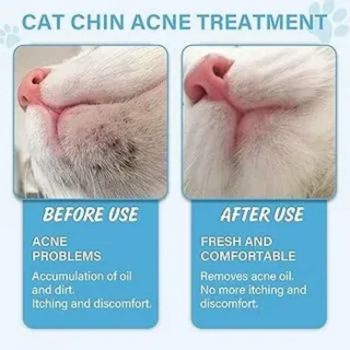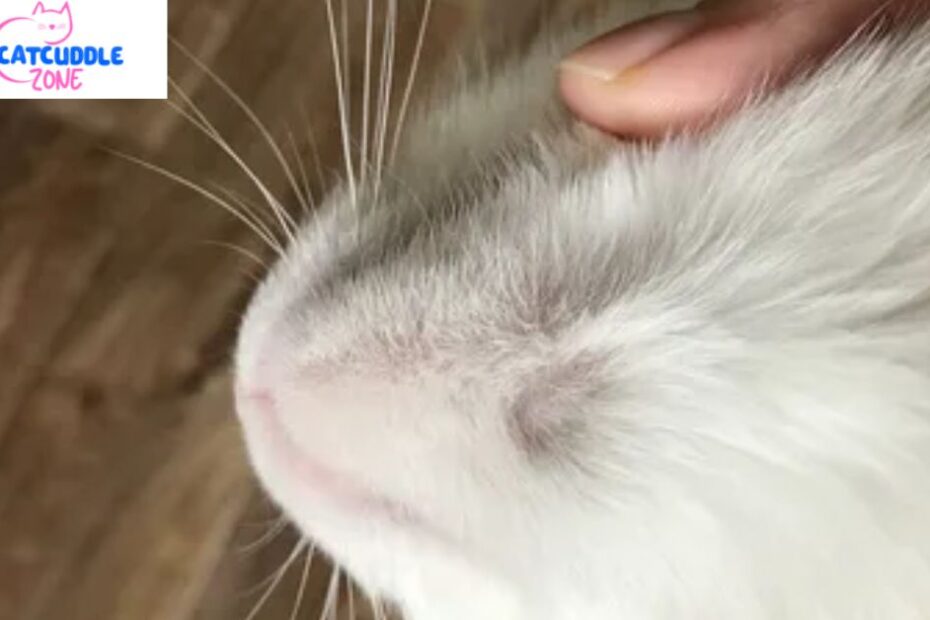Noticing strange bumps or redness on your cat’s chin? You’re not alone. Many cat owners get confused trying to figure out if it’s acne or mites. This vet-reviewed guide on “cat chin mites vs acne” breaks it all down in simple terms. Both conditions can cause an itchy chin in cats, but they have very different causes and treatments.
Whether it’s cat chin skin conditions, stubborn cat chin bumps, or unseen feline skin mites, understanding the difference is key. Let’s explore how to spot the problem early, what signs to watch for, and how to get your furry friend relief fast.
What Are Cat Chin Mites?
Cat mites are tiny bugs that live on the skin or in the fur. You can’t always see them. These mites are not a special type that lives only on the chin, but some types of feline skin mites may show up there. Mites on cat skin can cause itching, bumps, and redness. These signs are easy to confuse with other cat chin skin conditions.
Mites are some common mites in cats and they include cheyletiella, demodex, sarcoptes, notoedres, and otodectes. Both may cause varied skin irritation depending on the cat. Scabbing, hair loss, or crusty skin may result from these mites. They also tend to be contagious to other pets or even human beings. Infestation of mites is usually not very dangerous, yet uncomfortable.
What Is Cat Chin Acne?
Chin acne is one of the most common cat dermatology problems seen in vet clinics. Cats of all ages can get it, but it usually starts in adulthood. This condition happens when the hair follicles on the chin get clogged with oil or dirt. It may lead to blackheads, pustules, or cat chin bumps. The area often becomes red, swollen, or itchy.
No one knows the exact cause, but some believe plastic bowl allergy in cats might be a reason. Others think poor grooming, allergies, or bacteria may trigger it. Some even believe demodex mites in cats could play a small role. Mild cases might show a few tiny dots, while severe cases can lead to chin swelling, discharge, or even bleeding. This makes cat chin lesion treatment necessary in many cases.
Key Visual Differences Between Chin Mites & Acne
At first glance, both conditions can look similar. However, there are ways to tell them apart if you know what to look for. Cat mites often cause widespread itching, and the cat may start scratching behavior. The skin might look rough or show scabbing, while cat acne tends to stick to one area—the chin.
Acne usually looks like dirty dots, or cat blackhead removal may reveal gritty dark plugs. Mite infestation might show flaky skin, like walking dandruff. Severe cases of mites may cause feline skin infections, especially if the skin gets broken. Acne tends to be more oily in appearance, while mite damage might look dry and patchy.
| Feature | Chin Mites | Chin Acne |
| Location | Can spread to face or neck | Mostly on chin |
| Itching | Intense | Mild to moderate |
| Appearance | Flaky, red, scabby | Greasy, black dots |
| Contagious | Often | No |
| Commonness | Less common | Very common |
Causes of Chin Mites vs Cat Acne
The cause of cat mites often starts with exposure to another pet, a wild animal, or a dirty environment. Some cats are more sensitive to feline skin mites and may react strongly. Conditions like mange on a cat’s face or poor immune health can make them worse. Sometimes, mites are picked up from bedding or outdoors.
Cat acne, on the other hand, has many possible causes. It may be linked to plastic bowl sensitivity, dirt buildup, or even stress. Oily skin or poor grooming also plays a role. Sometimes, acne appears in cats who are otherwise very clean. That’s why it’s often hard to pinpoint the reason, making identifying skin issues in cats tricky.
Common Symptoms & How to Identify Each Condition
Look closely at your cat’s chin. If you see redness, cat scabs on the chin, or lots of scratching, it might be mites. Severe chin swelling in cats or signs of drooling and pain can also be caused by irritation from mites. These signs usually spread and worsen over time.
In contrast, cat acne home remedies often focus on simple cleaning. Acne usually appears as dark specks that may look like coffee grounds. You might notice blackheads, a greasy feel, or mild skin irritation. It doesn’t always itch, but if it becomes infected, it can develop pustules or turn red and painful.
What Else Can Mimic Mites or Acne in Cats?
Several other conditions can look similar. Flea fraas, also called cat flea dirt vs acne, often shows up as black specks. But they usually appear near the tail or back, not the chin. When in doubt, check if the dark spots move—fleas are fast.
In rare cases, mouth cancer or severe feline dermatology issues may mimic acne. These cases often involve swelling, odd odors, or discharge from the mouth. Your cat might stop eating or grooming. Infections, ringworm, or allergies can also cause cat chin redness and hair loss.
How Vets Diagnose Chin Acne vs. Mite Infestations
Vets have a test known as a trichogram, in which the vet removes some hairs and examines them using a microscope. This assists in identifying Demodex, Sarcoptes, or any other type of mite. They can also perform microscopic examination of skin scrubbing or sticky tapes. Complete diagnosis may be done, which involves examination of bacteria or fungi.
Diagnosis of acne generally goes through physical examination. Vets examine visual clues, touch the texture, and even inquire about the grooming habits of your pet. At some time, when the case is extreme, they may examine the bacteria beneath the skin. This will prevent the administration of the wrong treatment, which would have been caused by not understanding the root cause.
Treatment Options for Chin Mites & Chin Acne
For mite infestation, your vet may prescribe a topical medication that kills mites over several weeks. These are often flea treatments that also target feline skin mites. In some cases, medicated shampoos or injections are used. You might need to wash bedding and clean the home to prevent reinfection.
Feline acne treatment depends on severity. For mild cases, daily cleaning and switching bowls can help. Some vets recommend oral anti-inflammatories or topical creams to reduce swelling. Avoid harsh human products. For deep infections, antibiotics may be needed. The key is gentle, daily care and watching for changes.

Preventive Care & Home Management Tips
Preventing cat chin skin conditions means staying ahead of problems. Switch to ceramic or steel bowls to avoid plastic bowl sensitivity. Wash bowls daily. Keep the chin area clean using pet-safe wipes. Cats with long hair may need trimming near the chin.
Watch for signs of scratching behavior, redness, or oil buildup. Create a weekly pet skin care routine that includes gentle brushing. Catching early signs of cat skin mites symptoms or acne can save your pet from long-term discomfort.
When to See a Vet (Red Flags to Watch For)
If your cat shows signs like severe chin swelling, bleeding, deep scabbing, or stops eating, it’s time to call the vet. Other signs include discharge, licking the chin too much, or sudden behavior changes. These might signal something more serious than acne or mites.
Don’t put it off any longer. Not heeding these warning signs may lead to infections or permanent damage. At times, early diagnosis is the difference between a fast fix and a long-standing problem. Clear a photo to display to your vet whenever making an appointment.
Final Thoughts: Quick Recap & Best Approach for Pet Owners
Knowing the difference between cat chin mites vs. acne helps you act quickly. Acne is more common and often easy to treat. Less frequent and more contagious but irritating is the use of mites. Both lead to irritations on the skin and may result in loss of hair or infection when left unattended.
Stay proactive. Clean bowls, examine your cat weekly under the chin, and talk to your vet whenever something does NOT seem right. Good care and taking action promptly will help your cat to avoid the itch, pain, and stress that these disorders present.
(FAQs)
How do you treat chin mites in cats?
Chin mite treatment uses drugs prescribed by a vet, which are either topically applied or anti-parasitic drops, to kill the infestation of the mites and calm the skin irritation.
How to tell the difference between cat acne and flea dirt?
Cat acne stays on the chin and feels oily with blackheads, while flea fraas or cat flea dirt vs acne often shows up near the tail and moves when combed.
How do I clear my cat’s chin acne?
Keep the area clean every day, avoid plastic bowls, and follow vet advice for feline acne treatment, possibly it is gentle wipes or oral anti-inflammatories for swelling.
What does feline chin acne look like?
No, selection will aggravate the irritation on the skin, it will be painful and even lead to feline skin infection, or skin-bloody spots-but rather safe home remedies for cat acne.
Can I pick at my cat’s chin acne?
No, picking will only worsen the skin irritation, cause pain and even result in feline skin infection, or skin-bloody spots-instead, use safe home remedies of cat acne.
